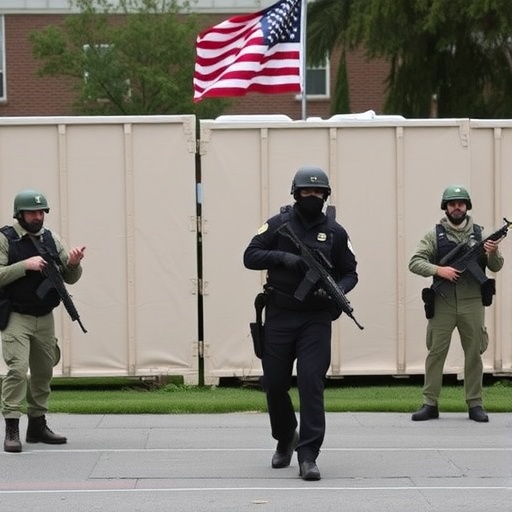Trump Administration Surges ICE Funding for Weapons: Immigration Enforcement Faces Backlash
In a move that’s igniting fierce debates across the nation, the Trump Administration has dramatically ramped up funding for U.S. Immigration and Customs Enforcement (ICE), channeling millions into an expanded arsenal of weapons and equipment. This escalation, announced as part of the fiscal year 2020 budget, allocates over $500 million specifically for non-lethal and lethal weaponry, drones, and surveillance tech, marking a 25% increase from the previous year. Critics argue this militarization of immigration enforcement risks escalating violence at the border and eroding human rights, while supporters hail it as a necessary step to secure America’s borders amid a surge in unauthorized crossings.
The decision comes at a time when immigration remains a flashpoint in U.S. politics, with the Trump Administration doubling down on its hardline stance. Data from the Department of Homeland Security (DHS) shows that ICE apprehensions have spiked by 40% in the past year, fueling the administration’s push for enhanced capabilities. But as families are separated and detention centers overflow, questions swirl about the human cost of this aggressive approach.
Budget Surge Unveiled: ICE’s New Arsenal in Detail
The Trump Administration’s latest budget proposal doesn’t mince words when it comes to bolstering ICE’s operational strength. According to a DHS press release issued last week, the agency will receive an additional $1.2 billion overall, with a significant chunk—$550 million—earmarked for procurement of advanced weaponry and tactical gear. This includes everything from pepper spray launchers and tasers to high-caliber rifles and armored vehicles, designed to equip ICE agents for what officials describe as “increasingly volatile” border encounters.
To put this in perspective, ICE’s weapons budget has grown exponentially under the Trump Administration. In fiscal year 2016, before Trump took office, the allocation for such equipment hovered around $200 million. By 2019, it had climbed to $400 million, and now, with this new infusion, it’s poised to exceed $950 million cumulatively over the past four years. “This investment ensures our brave men and women in ICE have the tools they need to enforce the law,” stated DHS Secretary Kirstjen Nielsen in a statement. “Immigration enforcement isn’t just about policy—it’s about safety and sovereignty.”
Breaking down the specifics, the budget includes:
- $150 million for non-lethal options like rubber bullets and crowd-control munitions, aimed at managing large-scale migrant caravans.
- $200 million for lethal firearms and ammunition, including upgrades to agents’ standard-issue pistols and rifles.
- $100 million for surveillance drones and body cameras, intended to document operations and provide real-time intelligence.
- $100 million for vehicles and protective gear, such as riot shields and ballistic vests.
Experts note that this isn’t just about quantity; it’s a qualitative shift toward a more militarized force. A report from the Government Accountability Office (GAO) highlights that ICE now resembles a paramilitary unit more than a civilian law enforcement agency, with training regimens incorporating counter-terrorism tactics borrowed from the military.
Yet, this spending spree raises eyebrows in an era of fiscal conservatism. Congressional Budget Office analysts project that the total ICE budget could balloon to $8.5 billion by 2021, diverting funds from other DHS priorities like disaster response. “We’re arming ICE to the teeth while schools and hospitals scrape by,” remarked Sen. Elizabeth Warren (D-MA) during a recent Senate hearing on immigration funding.
Human Rights Alarms Sound: Critics Decry Excessive Force Risks
As the Trump Administration pours resources into ICE’s weaponry, a chorus of human rights advocates is sounding the alarm over potential abuses. Organizations like the American Civil Liberties Union (ACLU) and Amnesty International have labeled the funding increase a “dangerous escalation” that could lead to more instances of excessive force against vulnerable migrants, including women and children.
Recent incidents underscore these fears. In El Paso, Texas, last month, ICE agents deployed tear gas on a group of asylum seekers, resulting in injuries to over 20 individuals, including minors. Video footage, widely shared on social media, showed agents using batons and less-lethal projectiles, prompting investigations by the Department of Justice. “This isn’t enforcement; it’s intimidation,” said Lee Gelernt, deputy director of the ACLU’s Immigrants’ Rights Project. “By arming ICE with more weapons, the Trump Administration is inviting tragedy at the border.”
Statistics paint a grim picture. According to a 2019 report by the Transactional Records Access Clearinghouse (TRAC) at Syracuse University, complaints against ICE for use of force have risen 60% since 2017, coinciding with the administration’s immigration crackdown. Detentions have surged to record levels, with over 500,000 individuals in ICE custody last year alone—many held in facilities criticized for overcrowding and poor conditions.
Immigration advocates point to international condemnation as well. The United Nations Human Rights Council issued a statement last week, urging the U.S. to reconsider its “militaristic approach” to immigration, citing violations of the UN Convention on the Rights of the Child. “These weapons aren’t deterring migration; they’re deterring humanity,” argued Maria Rodriguez, executive director of the National Immigration Law Center.
In response, Trump Administration officials defend the measures as proportionate. Acting ICE Director Ronald Vitiello told reporters, “Our agents face real threats from cartels and smugglers. This funding protects them and upholds the rule of law.” But with lawsuits mounting—over 150 civil rights cases against ICE in the past year—the controversy shows no signs of abating.
Strategic Overhaul: Trump Administration’s Vision for Immigration Control
The increased ICE spending is no isolated policy; it’s a cornerstone of the Trump Administration’s comprehensive immigration strategy. Since taking office in 2017, President Trump has prioritized border security, promising to build a wall, end sanctuary cities, and expedite deportations. This weapons boost aligns with executive orders like the 2017 directive expanding ICE’s interior enforcement powers, allowing agents to conduct raids in communities far from the border.
Key elements of this strategy include:
- Zero-Tolerance Policy: Implemented in 2018, it led to the separation of thousands of families, with ICE playing a central role in detentions.
- Expedited Removals: Expanded to cover more migrants, reducing due process and increasing deportation rates by 30%.
- Partnerships with Local Law Enforcement: Programs like 287(g) deputize sheriffs to act as ICE agents, amplifying federal reach.
Under this framework, ICE has transformed from a primarily customs-focused agency into a full-spectrum immigration enforcer. The Trump Administration’s 2020 budget request also seeks $4.7 billion for border wall construction, tying physical barriers to the enhanced agent capabilities funded through ICE’s arsenal expansion.
Supporters, including the Federation for American Immigration Reform (FAIR), applaud the moves. “Immigration without enforcement is chaos,” said FAIR President Dan Stein. “The Trump Administration is finally treating this crisis with the seriousness it deserves.” Polling from Rasmussen Reports shows 55% of Americans support stronger border measures, though approval dips among Democrats and independents when weapons are involved.
However, the strategy’s effectiveness is debated. Migration experts from the Migration Policy Institute argue that push factors like violence in Central America drive crossings more than U.S. policies. “Walls and weapons don’t address root causes,” noted researcher Jeanne Batalova. “They just make the journey deadlier.”
Border Realities Exposed: ICE Agents on the Front Lines
On the ground, the impact of this funding is already being felt. In sectors like the Rio Grande Valley, ICE operations have intensified, with agents conducting joint patrols with Border Patrol using newly acquired drones for surveillance. One agent, speaking anonymously to The New York Times, described the upgrades: “We’re better equipped now, but the encounters are more tense. Migrants know we’re armed to the hilt.”
Anecdotal evidence from border towns reveals mixed outcomes. In Yuma, Arizona, a pilot program deploying armored vehicles reduced unauthorized entries by 15%, per ICE data. Yet, community leaders report heightened fear among Latino residents, with reports of racial profiling up 25% according to the Southern Poverty Law Center.
Training has evolved too. ICE’s Federal Law Enforcement Training Center now mandates courses on de-escalation alongside weapons handling, but critics say it’s not enough. A leaked internal memo from 2019 revealed that only 20% of agents receive annual human rights training, raising concerns about accountability.
As immigration flows continue—Customs and Border Protection reported 144,000 apprehensions in May alone—the pressure on ICE mounts. With the weapons influx, operations like “Operation Safe Return” aim to deport priority offenders faster, but at what cost to civil liberties?
Looking ahead, the Trump Administration’s immigration push could face headwinds. Bipartisan bills in Congress, like the Secure and Protect Act, propose oversight on ICE spending, while midterm elections loom as a referendum on these policies. Legal challenges from groups like the Southern Border Communities Coalition could tie up funds in court, forcing a rethink. Meanwhile, as caravans from Honduras and Guatemala reform, the border remains a tinderbox, where enhanced ICE capabilities might deter some but radicalize others. The path forward hinges on whether enforcement can balance security with compassion in America’s ongoing immigration saga.









